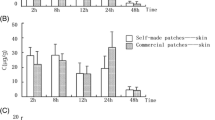Abstract
The pharmacodynamic measurement of in vivo skin penetration of lidocaine was explored with an instrument used in dentistry to determine tooth pulp vitality. The instrument delivers a low-current, pulsatile electrical waveform of increasing intensity with time. The readings, which are reproducible, are in arbitrary units on a scale of 0–80. Testing of naive sites showed variation as a function of location, even over relatively small distances. The response at a marked site over a 12-hr period generally was consistent in five subjects. Following intradermal administration of 1 or 2% lidocaine hydrochloride injection in one subject, the instrument reached its maximum value within 2 min. This was followed by a sustained plateau and then a gradual falloff of the effect. Topical formulations containing 5% lidocaine base and corresponding blank formulations were applied under occlusion within Hilltop chambers to intact skin on the forearms of human volunteers for 3 hr. While the response to a 40% propylene glycol formulation was not significantly different from the corresponding control, a cream exhibited slow development of profound anesthesia that lasted for several hours following chamber removal.
Similar content being viewed by others
REFERENCES
T. G. Brown and F. P. Luduena. Anesthesiology 14:555–556 (1953).
B. Ackerman, G. Hagerstrom, B. G. Preng, and R. Sandberg. Acta Pharmacol. Toxicol. 45:58–65 (1979).
A. H. Campbell, J. A. Stasse, G. H. Lord, and J. E. Wilson. J. Pharm. Sci. 57:2045–2048 (1968).
H. Hampel. Arzneim.-Forsch. 18:919–931 (1968).
J. D. Hardy, H. G. Wolff, and H. Goodell. J. Clin. Invest. 19:649–657 (1940).
W. Bartsch and K. Knopf. Arzneim.-Forsch. 20:1140–1143 (1970).
A. W. McKenzie and R. B. Stoughton. Arch. Dermatol. 86:608–610 (1962).
B. W. Barry and R. Woodford. Br. J. Dermatol. 91:323–338 (1974).
D. Campbell and J. Adriani. JAMA 168:873–877 (1958).
J. Adriani and R. Zepernick. JAMA 188:711–716 (1964).
H. Dalili and J. Adriani. Clin. Pharmacol. Ther. 12:913–919 (1971).
B. Ponten and L. Ohlsen. Br. J. Plast. Surg. 30:251–254 (1977).
D. F. McCafferty, A. D. Woolfson, K. H. McClelland, and V. Boston. Br. J. Anaesth. 60:64–69 (1988).
G. M. E. Ehrenstrom-Reiz and S. L. A. Reiz. Acta Anaesth. Scand. 26:596–598 (1982).
P. Procacci, M. Zoppi, M. Maresca, and S. Romano. In J. J. Bonica (ed.), Advances in Neurology, Vol. 4. Pain, Raven Press, New York, 1974, pp. 107–113.
L. Arendt-Nielsen and P. Bjerring. Anesth. Analg. 67:115–123 (1988).
R. L. Cooley, J. Stilley, and R. M. Lubow. Oral Surg. Oral Med. Oral Pathol. 58:437–441 (1984).
T. Kiyamura, T. Takahashi, and H. Horiuchi. Jap. J. Conserv. Dentist. 22:202–208 (1979).
Z. Fuss, H. Trowbridge, I. B. Bender, B. Rickoff, and S. Sorin. J. Endodont. 12:301–305 (1986).
L. J. Drevan, A. Reader, F. M. Beck, W. J. Meyers, and J. Weaver. J. Endodont. 13:233–238 (1987).
Analytic Technology, 2006 Vitality Scanner Product Information, Redmond, WA, 1985.
R. J. Scheuplein and I. H. Blank. Physiol. Rev. 51:702–747 (1971).
S. R. Rothman. Physiology and Biochemistry of the Skin, University of Chicago Press, Chicago, 1954.
Author information
Authors and Affiliations
Rights and permissions
About this article
Cite this article
Kushla, G.P., Zatz, J.L. Evaluation of a Noninvasive Method for Monitoring Percutaneous Absorption of Lidocaine in Vivo . Pharm Res 7, 1033–1037 (1990). https://doi.org/10.1023/A:1015939100073
Issue Date:
DOI: https://doi.org/10.1023/A:1015939100073




